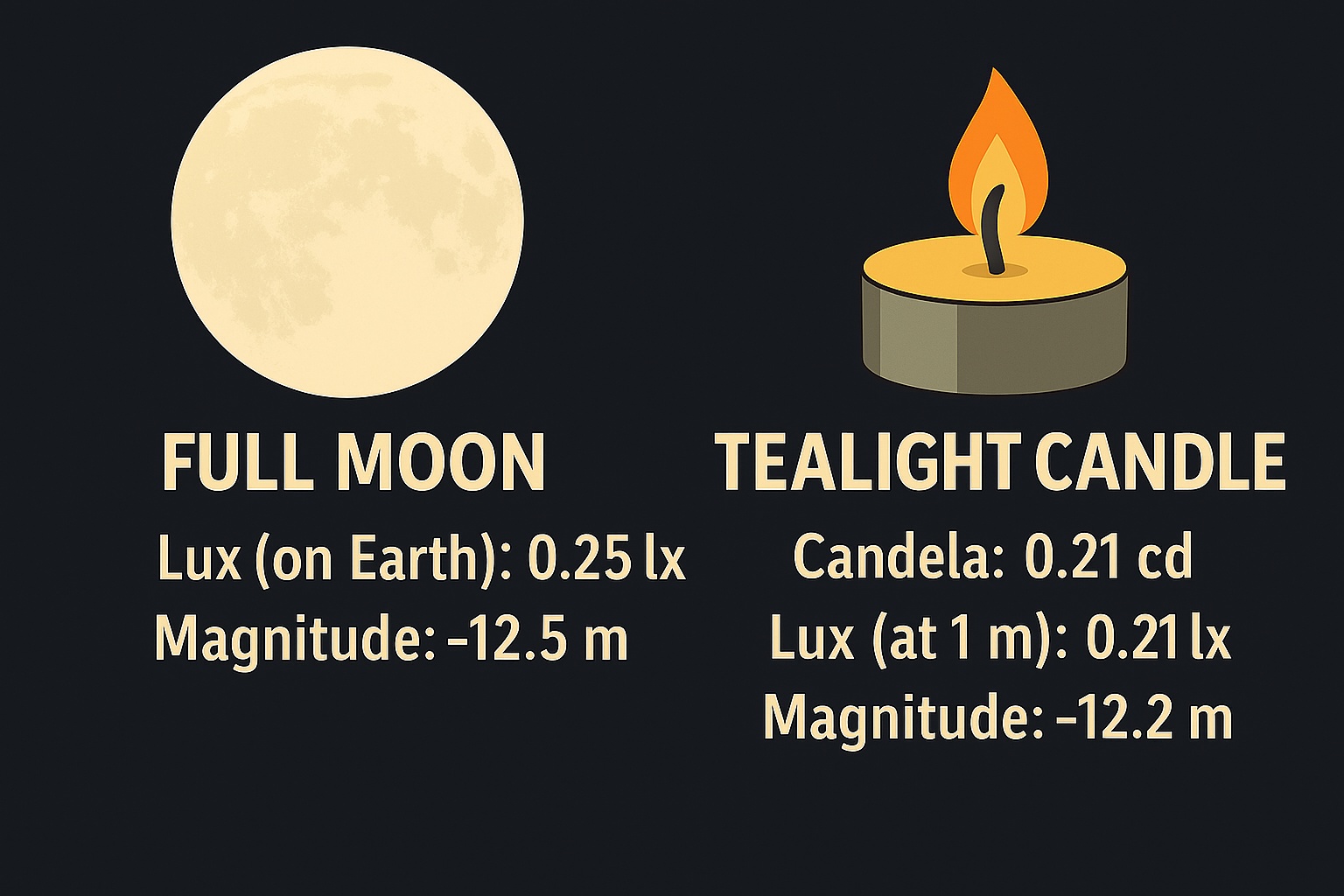Understanding Candela, Lux and Magnitude
Brightness scales in astronomy can feel abstract, yet a humble tealight candle can bring them down to Earth. In this article we use an ordinary paraffin tealight to unpack three key photometric units: candela (cd), lux (lx) and stellar magnitude (m).
What Does a Tealight’s Light Reveal?
A typical metal-cup tealight burns for ≈ 6 h, consuming about 1.7 g of paraffin per hour. The flame produces a luminous flux of roughly 2.6 lumens (lm).
- Luminous intensity (candela)
\[
I = \frac{\Phi}{4\pi}
= \frac{2.6\,\text{lm}}{4\pi}
\approx 0.21\,\text{cd}.
\]
- Illuminance (lux) at 1 m
\[
E = \frac{I}{r^{2}}
= \frac{0.21\,\text{cd}}{(1\,\text{m})^{2}}
\approx 0.21\,\text{lx}.
\]
Thus a tealight delivers ≈ 0.2 cd of luminous intensity and ≈ 0.2 lx at one metre.
Candela, Lux and Magnitude—at a Glance
| Unit | Meaning | Tealight (1 m) |
|---|---|---|
| Candela (cd) | luminous intensity | ≈ 0.2 cd |
| Lux (lx) | illuminance on a surface | ≈ 0.2 lx |
| Magnitude (m) | astronomers’ logarithmic brightness scale | ≈ –12.2 m |
Magnitude calculation
Using \[ m = -2.5\,\log_{10}\!\Bigl(\tfrac{E}{E_{0}}\Bigr), \qquad E_{0}=2.54\times10^{-6}\,\text{lx}, \] we have \[ \frac{E}{E_{0}} =\frac{0.21}{2.54\times10^{-6}} \approx 8.3\times10^{4}, \qquad m\approx -2.5\log_{10}(8.3\times10^{4})\approx -12.2. \]
(The often-quoted –6.9 m figure found online results from using foot-candles or an incorrect reference \(E_{0}\).)
A handy rule of thumb: 1 cd produces 1 lx at 1 m; because a tealight’s luminous flux is ≈ ⅕ of a “standard candle” (12 lm), its cd-value is likewise ≈ ⅕.
Tealight vs. Full Moon
| Source | Illuminance | Apparent magnitude |
|---|---|---|
| Tealight (1 m) | 0.21 lx | –12.2 m |
| Full Moon | 0.25 lx | –12.5 m |
Although the lux numbers are almost identical, the full Moon’s magnitude is ~0.3 mag brighter—on the log scale that is ≈ 1.35 × the visible flux. (Claims of “250 × brighter” stem from the outdated –6.9 m value.)
Why Isn’t a Tealight 1 Candela?
- Flame size – a tealight’s flame (< 1 cm across) is far smaller than the ~3 cm flame of a classic taper or spermaceti candle.
- Spectral output – paraffin flames are rich in red/yellow; human photopic vision peaks at 555 nm (green).
- Fuel rate – 1.7 g h⁻¹ vs. the historical 7.8 g h⁻¹ “standard candle”; luminous flux scales roughly with mass burned.
Net result: \[ I_{\text{tealight}} \approx 1\,\text{cd}\times\frac{2.6\,\text{lm}}{12\,\text{lm}} \approx 0.22\,\text{cd}. \]

By the light of a single candle, medieval monks transcribed sacred texts inside stone-walled monasteries.
Conclusion
Up close, a tealight feels bright, yet its 0.2 cd intensity is only a fifth of the old 1 cd standard candle. Meanwhile the full Moon, delivering ~0.25 lx at Earth’s surface, shines at –12.5 m—just a shade brighter than our candle at arm’s length! This comparison shows why astronomers rely on logarithmic magnitudes, not raw lux, to span the vast dynamic range between everyday lights and cosmic beacons.
Next time you light a tealight, remember: that tiny flame is a pocket laboratory for the night-sky brightness scale.
All formulae verified against CIE and IAU photometric standards (2024).
